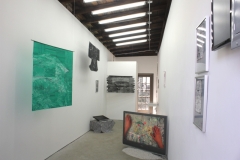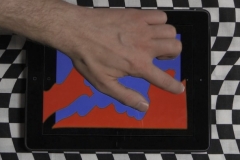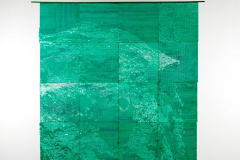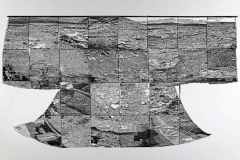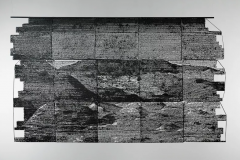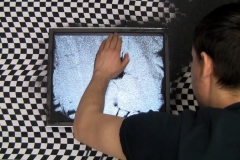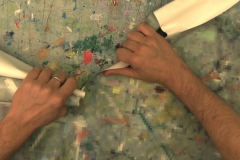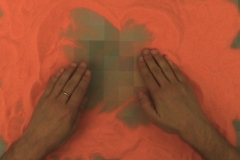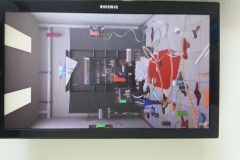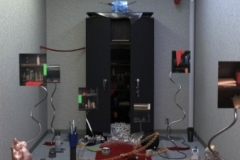Mitch Patrick “repeaters”
Auxiliary Projects is pleased to present “repeaters,” the first New York solo exhibition by Mitch Patrick, from June 4 through July 15, 2016. There will be an opening reception on Saturday, June 4, from 6-8pm. The gallery is open Saturdays and Sundays from 1-6pm and by appointment.
“repeaters” will include drawings, videos, and 3D-printed image-based sculptures, each playing with human perception and the limits of the image’s ability to represent reality. In Patrick’s works, analog and digital processes and imagery are combined, often to disorienting effect. Patrick’s videos are a mashup of both, unsettling our perception as our eyes attempt to land on solid visual ground. Ripper shows two hands tearing apart successive layers of what first appears to be a grid of large colored squares, each ripped layer zooming out further as pixels resolve, until what is being torn apart is a recognizable paint-spattered surface. Picker, inspired by a 1968 Richard Serra 16mm film showing hands scooping up metal shavings, presents an aerial view of a face-up computer screen obscured by a mound of black sand. Over the next 9 minutes, the hands of a figure (the artist himself) scoops, wipes and eventually picks the screen clean of every last speck. The image on the screen, when unobscured, is revealed to be sand itself, as if to posit that reality is resistant to representation.
Patrick will also be exhibiting a series of 3D-printed images. Each composite image, suspended away from the wall, is comprised of rows and columns of 3D-printed shapes. The shapes are a custom alphabet Patrick invented, analogous to ASCII but without recognizable letters. Up close, the images are comprised of repetitive writing-like gestures of filament; from a distance, the image resolves into cosmological photographs created by space exploration vehicles to represent the landscape of Mars and a comet. The aesthetic texture of a barren planetary landscape is well represented by this technique; equally important is the apparatus and mechanics of the image’s creation. In the purest use of photography – that is, to transmit information about something otherwise inaccessible to humans – NASA’s Curiosity Rover interprets the visual landscape as bytes. Patrick’s 3D-printer translates the bytes back into visual landscapes that are also physical objects, at far lower resolution. These manipulations, like the video “Ripper”, are permutations of the image that call to mind the writing of Vilém Flusser. In the preface to “Into the Universe of Technical Images” Flusser lays out the terrain:
Texts have recently shown themselves to be inaccessible. They don’t permit any further pictorial mediation. They have become unclear. They collapse into particles that must be gathered up. This is the level of calculation and computation, the level of technical images.
Also on view will be a series of small, elaborate pen and ink Diagraphein & Glyphein drawings, intuitively created but springing from similar visual imagery, and a series of small, wall-based 3D printed Gridsnake sculptures. These revel in speculative fictions that attempt to posit the act of entering reality and diagramming a process from an alien vantage point. We aren’t fooled however, like the apocryphal story of DeKooning looking at a drawing by an elephant and congratulating his skill, the best response is, “That alien sure can draw!”
